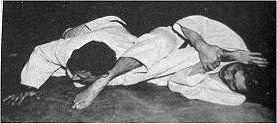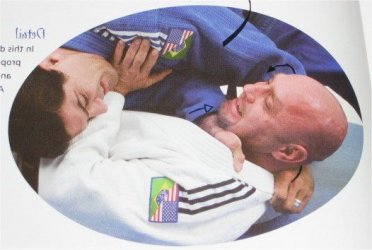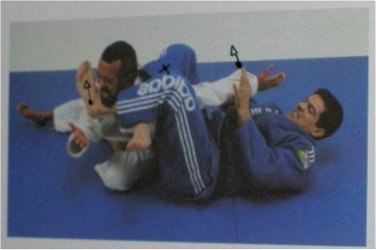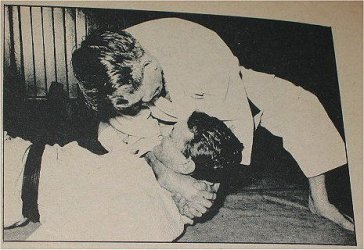Ceicei, I am glad to hear you are still at it, and martial talk has helped you through some of your first hurdles. I hope some of my tips help steer you around a few of the unseen ones.
I realize the males outweigh most of us, but wouldnt that be a good thing to learn by working with them? Its best to learn the technique (waza) on a similarly sized opponent until you perfect it, less injuries.
Gaston, you mentioned about flexing the wrist with morote-seoi-nage. I took your advice and that helped. A new problem came up with practicing this technique. When my elbow goes into her armpit and under her arm, I found that my elbow became hyperflexed because of her weight. Perhaps Im doing something incorrectly because when I went home, I barely could use my elbow as it was so sore. Ive had hyperextended joints, but it was a new experience to have a joint hyperflexed.
Sorry to hear about your elbow, for future if something feels like it is injuring you check it out right away. A small change in any MA technique can make a huge difference. Hopefully your access the many experienced grapplers here, allows you to learn from our tips/mistakes. Try to focus on this sequence for most forward throws: Drop (lower your body as you are stepping in) - Lock (their body to yours with at least 50% of their weight higher than your hips) - Throw (Allow them to fall over your body, its harder to stop a good throw at this point than to just let it happen) The majority of the arm pulling is to lock them to your body not to provide lift. The friction between your back and their front usually provides sufficient lift. At first people try to throw their opponent up and over with their arms. Then they realize their opponent is already standing and all they need is something / someone to fall over. Just squat a little on entry and if they are properly off-balanced they will feel weightless as you allow them to fall over you. Use your joints (hips & knees) as pivots for them to fall over. Try this exercise, (It is actually called Sode-Tsurikomi-Goshi) have someone stand behind you with their arms raised. Squat about 3-4inches and have them lean into you. With both hands, elbows strait grab the ends of their long sleeves. Then bend at the hip so they stay put on your back & straiten your knees, their weight should be helping. If you were to try & lift the same person by standing strait and pushing up with just your arms, you had best be VERY strong, and they not taller than you. Now just change your grip for morote-seoi-nage and watch them fly.
I learned another type of throw (Uchi-mata). I keep my right hand on her left label and my left hand on her right sleeve. My right foot steps forward between her feet, closer to her right foot. I pivot on my left leg, turning around with my back towards my uki, but instead of putting my weight on both of my feet; I sweep my right leg backwards against her right leg. That proved to be difficult to do, since I see the other Tori/uki both loose balance and fall. I hadnt fallen down doing this, but I tend to let go a bit too early before she falls because I do not complete the full rotation.
In Uchi-mata your uki falls in more of a sideways rotation around your leg. It is a different feeling at first. Remember, as before your leg is just something to guide their fall, not to lift them. Follow the above sequence, only this time lock them more to your back/side (hip). The whole reason the leg goes up is to prevent them form stepping around the throw & allow your hip to lift higher.
One final throw (???) I learned was sort of like kosoto-gari, but this one was with my left foot hooking behind her right ankle instead of her knee.
Next, we then learned some chokes/strangleholds.
(With Hadaka jime ensure the thumb side of your wrist is just above their voice box and centered under the chin) I stood behind my uki and put my right arm around her neck, grasping my right hand with my left hand.
The next choke I learned (Okuri eri jime) had my right hand grasping her left collar, almost behind her neck, but keeping my right forearm horizontal. Apparently (Not sure what you mean here?) all the chokes I learned require the choking arm to be horizontal, working more like a bar than a choke with the elbow out front. My left hand grasps her right lapel and pulls down on it. The third choke (???) was similar, except that my left hand grasps her left lapel and pulls down on it. (Help you have lost me)
The fourth choke (Kata ha jime) was more fun
my right hand grasps her left collar high behind her neck, and my left arm loops under her right arm, then goes around to the back of her head (kind of like half of a nelson one sided).(good description!) The fifth choke Nami-juji-jime or Gyaku-juji-jime palms down or up usually the second from underneath) was having my uki mount me while Im on my back. I cross my hands and grasp her lapels high up her collar (my right hand on her right lapel and my left hand on her left lapel) and apply an opposing pull. This last one was easy to do as this choke is also known in my primary art, American Kenpo.
Sadly, we ran out of time to do randori. I had been looking forward to randori since its the only time I can try out what I learned on a resisting partner.
- Ceicei
Keep it up!! It only gets better.




